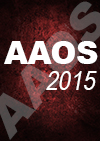
AAOS 2015: No difference between topical and intravenous tranexamic acid for TKA

AAOS 2015: No difference between topical and intravenous tranexamic acid for TKA
The Effect of Topical Tranexamic Acid during Arthroplasty of the Knee on Blood Loss
Did you know you're eligible to earn 0.5 CME credits for reading this report? Click Here
CONFERENCE ACE REPORTS
This ACE Report is a summary of a conference presentation or abstract. The information provided has limited the ability to provide an accurate assessment of the risk of bias or the overall quality. Please interpret the results with caution as trials may be in progress and select results may have been presented.
Synopsis
131 patients undergoing total knee arthroplasty were randomized to receive tranexamic acid either topically, with 2mg injected intra-articularly following capsular closure, or 1 mg intravenously prior to tourniquet inflation and another 1mg prior to tourniquet deflation. Postoperative hemoglobin levels and cumulative blood loss were assessed for 3 days postoperatively, and length of stay, discharg...
To view the full content, login to your account,
or start your 30-day FREE Trial today.
FREE TRIAL
LOGIN
Forgot Password?
Explore some of our unlocked ACE Reports below!

Learn about our AI Driven
High Impact Search Feature
Our AI driven High Impact metric calculates the impact an article will have by considering both the publishing journal and the content of the article itself. Built using the latest advances in natural language processing, OE High Impact predicts an article’s future number of citations better than impact factor alone.
Continue



 LOGIN
LOGIN

Join the Conversation
Please Login or Join to leave comments.